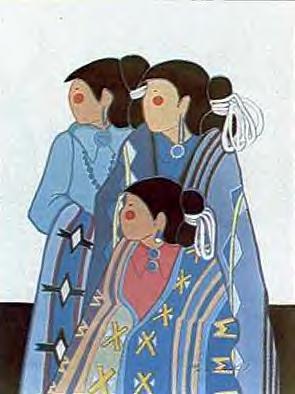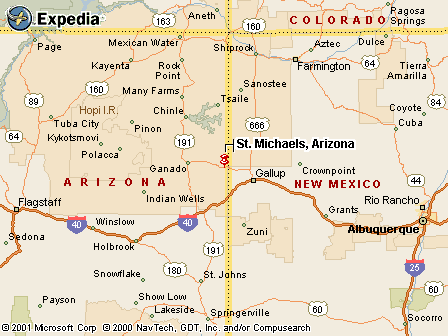|
|
Canku Ota |
|
|
(Many Paths) |
||
|
An Online Newsletter Celebrating Native America |
||
|
June 30, 2001 - Issue 39 |
||
|
|
||
|
Early Childhood Program Helping Youngsters Prepare for School |
||
|
by Nathan J. Tohtsoni The Navajo Times - June 15, 2001 |
||
|
art Navajo Three by Virginia Stroud |
 ST. MICHAELS, AZ - On a recent afternoon, Laurinda Moore of Fort Defiance signed
up her two-year-old son, Latreyal Moore, for an early childhood program because she believes in its importance. ST. MICHAELS, AZ - On a recent afternoon, Laurinda Moore of Fort Defiance signed
up her two-year-old son, Latreyal Moore, for an early childhood program because she believes in its importance.The Early Bird program, located at the St. Michael Indian School, is designed to prepare a child not only for school, but for life. It helps newborns to four-year-old children to do well academically before they enter kindergarten. Early Bird joins similar early childhood intervention programs around the country that have improved children's social development skills. It has proven to be productive as well as giving children something to do when classes are on summer break. Studies have shown that children who have completed an early childhood program do better when they enter school than children who have not. Kids in the programs have proven to be better prepared for classroom assignments and tasks. "We like to do it before school starts," project director Wanda Hadley said of Early Bird's hands-on approach. "We like to let the parent know that they're their child's first teacher and, possibly, the best teacher." Based on similar programs in Harlem, N.Y., and New Orleans, La., Sister Loyola Edelen of the St. Michael Indian School found funding for Early Bird. Next month marks the program's fifth year of working with young Navajo children. The Alfred Harcourt Foundation in Silver Springs, Md., funds the program. Preparation to succeed "I would be happy if every child was given preparation to succeed in school," Edelen said. "The kids look cute, they look sweet, but for some, they can't do it in the next grade. Some students stand out as slow, as dumb, but they're not! Right now there's a big wide gap in kindergarten between their experience and the material they're expected to handle." If a child is better prepared to meet the challenge of kindergarten before they ever get there, Hadley said that child would only be better prepared for school all together. Frances Campbell, senior scientist of the Frank Porter Graham Child Development Center at the University of North Carolina in Chapel Hill, conducted a study for 21 years that has followed the lives of children from infancy to adulthood. The young adults attended a full-time childhood intervention program as babies and the study followed them to adulthood to see how their lives developed. "They weren't just laying around in cribs as children," Campbell said. "We were not warehousing children but we used that time to educate them that learning is fun. They did better in math and got further in school. They were less likely to have babies as teenagers. They learned that there's a great deal they can do. Now they're breaking down doors." Campbell has been through the Navajo Nation and has seen the socio-economics of the area. The children who went through the program in Chapel Hill were from similar backgrounds. They came from deprived backgrounds in the rural South, some single-parent households, and 98 percent of them are African-American, she said. Of the 104 people in the program, 35 have gone on to college. Campbell said that was remarkable considering that only five percent of their parents attended college. "What the study says is that a preschool program can make a big difference," she said. "The bottom line, from our experience, early childhood programs are important - money spent tends to be good money spent." Economically disadvantaged At the University of Arizona in Tucson, Angela Taylor, chairwoman of Family Studies and Human Development, has conducted research of kids from economically disadvantaged backgrounds enrolled in Head Start early intervention programs. When the Head Start program began in the early 1970s, kids entered the program a year before they enrolled in kindergarten. Taylor said expectations that a child would be better prepared to adapt to school with only one year of an early childhood program were unrealistic. Head Start changed the entrance age to three and within the past few years, Early Head Start have started taking newborns. "The benefits are greater if you can start the child earlier," Taylor said. "They've been able to stay on task and follow directions and their personal skills have improved." Research from the National Center for Early Development and Learning in Chapel Hill shows that the first three years of life are a time when essential experiences provide the basis for future cognitive, language and social development. "While we have accumulated valuable information concerning practices that enhance the development of young children, this comes primarily from children in the dominant culture," the center states. "We need to determine whether these practices enhance the development of all children, particularly children from diverse ethnic backgrounds." As Edelen has seen in her experiences of two inner city programs and the Navajo Nation, the Early Bird's objective has been effective with children from diverse backgrounds. "It prepares them to handle the standard curriculum that's used across the country," she said. Visits to WIC offices Early Bird makes visits to Women, Infants and Children offices where Hadley and program assistant Vikki Curley share information about the program. Children are evaluated and mothers are given material that fits their level. The "homework" consists of human and animal puzzles, nursery rhymes, bedtime reading material, tracing shapes, and other hands-on material. "There's pride in finishing a task and that carries onto kindergarten since they know they can finish something," Hadley said. "Sometimes when parents come into the office, they say 'Where's the preschool?' I say, 'It's at your house,'" she added. "This allows them to work at their own pace and it puts the responsibility on the parent to be teaching their children and see that they're learning something. It's up to the parent to do it." Moore has had two children go through the Early Bird program and she wanted Latreyal to share the same experience. "I enjoy working with them in the evening," Moore said. "My daughter Lailauni gets a lot of homework and the two little ones want to sit at the table and do something. I know this helped her." There are plans to expand Early Bird from its 50-mile radius service area to other parts of the reservation. The operating office is located at the St. Michael Indian School, but it is open to everyone. |
|
|
|
St. Michael Indian School |
|
|
||
|
|
||
| Canku Ota is a free Newsletter celebrating Native America, its traditions and accomplishments . We do not provide subscriber or visitor names to anyone. Some articles presented in Canku Ota may contain copyright material. We have received appropriate permissions for republishing any articles. Material appearing here is distributed without profit or monetary gain to those who have expressed an interest. This is in accordance with Title 17 U.S.C. section 107. | ||
|
Canku Ota is a copyright © 2000, 2001 of Vicki Lockard and Paul Barry. |
||
|
|
|
|
|
The "Canku Ota - A Newsletter Celebrating Native America" web site and its design is the |
||
|
Copyright © 1999, 2000, 2001 of Paul C. Barry. |
||
|
All Rights Reserved. |

